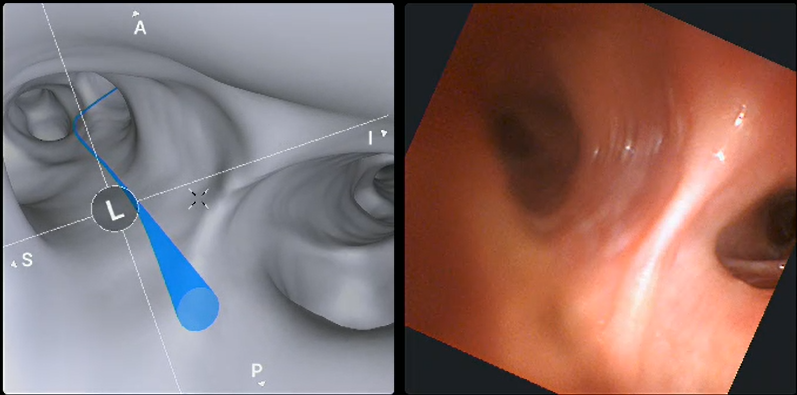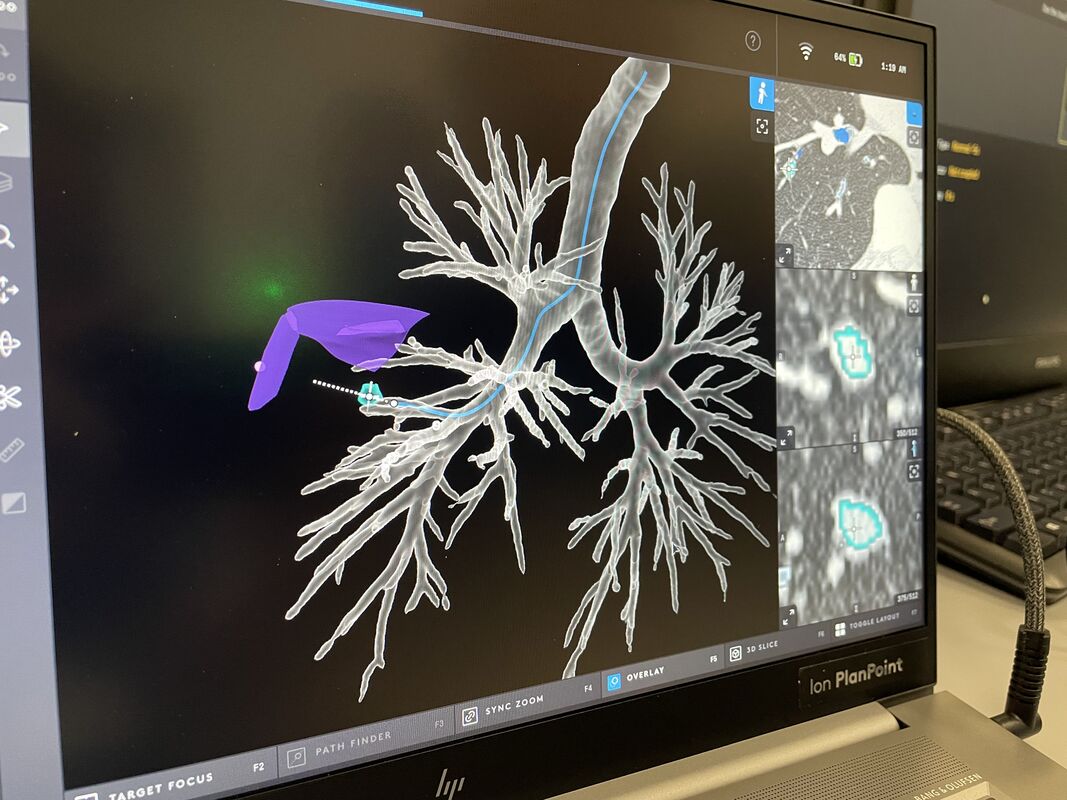What is the Ion robotic-assisted lung cancer biopsy?
A new robotic-assisted technology, the Ion endoluminal system (also known as ‘Ion’), allows respiratory specialists to take biopsies (tissue samples) of very small lung nodules which would otherwise be difficult to reach.
Under general anaesthesia, a very thin and flexible catheter (a thin tube) is inserted into your airways through your mouth, with a camera on the end of the tube that provides a view of your lungs and airways. When used in combination with a highly specialised CT scanner located in the procedural suite, your doctors can determine the exact location of the target nodule and collect very precise biopsies. While traditional biopsy methods may not be able to take biopsies from hard-to-reach areas of the lung, the improved flexibility, stability and precision of the Ion system opens up new possibilities for early cancer diagnosis.
In 2024, our Ion robot lung biopsy service received the prestigious LaingBuisson Award for ‘Innovation in Care,’ highlighting our respiratory specialists’ excellence in patient outcomes and innovation in lung cancer diagnostics. LaingBuisson is a renowned business intelligence provider in the healthcare sector.
Who is the Ion system for?
Potential lung tumours of a size of 6mm or smaller can be biopsied using the Ion system, so the procedure is suitable if you have had a very small nodule detected at the earliest stages of cancer. The Ion robotic-assisted lung biopsy procedure can also benefit patients who have previously been treated for lung cancer, where there is the need to understand how tumour tissues have changed, or if there is now a new suspected tumour in the lungs.
Other lung biopsy methods cannot reliably collect difficult to reach areas, and cannot always take samples from multiple areas, or both lungs in the same procedure. If you have nodules in both lungs, the Ion system can be used to take biopsies from each of them while you are under anaesthesia, halving the time you spend undergoing biopsy procedures.
Existing biopsy methods involve a needle being placed through the chest wall to acquire biopsies, guided by CT imaging technology for the greatest accuracy. These methods are suitable when potential tumours are larger, and they have a diagnostic accuracy rate of 95.3% at our hospitals. However, if you have nodules or tumours which are too small for these existing biopsy techniques, the Ion system can provide a highly precise method of collecting tissue samples, without the need to place a needle through the chest wall.
What does the Ion robotic-assisted lung biopsy show?
The Ion system creates a 3D roadmap of your airways and lungs, highlighting the tumours within each lung that need to be biopsied. The roadmap helps the clinician to navigate your airways and see exactly where each tumour is – similarly to a car satnav mapping out a route to follow.
The clinician can then use the Ion system’s biopsy tool to collect a tissue sample from precisely the correct location of the nodule or tumour in your lung. This biopsy sample is analysed in a laboratory to determine whether or not it is cancerous, informing your future treatment options.

3D roadmap of the lungs with the suggested access routes to the tumour shown by the blue line.
The smaller that a tumour is when detected, the sooner treatment can be offered, and the better your chances of being cured are. If the tumour is around 30mm in size, cure rates are 64-70%. If tumours are identified at a size smaller than 20mm, the cure rate is 83%. For tumours smaller than 10mm when detected, the cure rate is 92%.
The Ion system enables earlier diagnosis of tumours of a size of 6mm or smaller, therefore potentially improving survival rates in patients with lung cancer.
How to prepare for the Ion robotic-assisted lung biopsy
To ensure you are well-prepared for the biopsy procedure, it’s important that you follow all the instructions from our team of respiratory specialists. They will advise on whether you need to follow certain dietary guidelines or fast beforehand due to the general anaesthetic, and they will also provide you with realistic timelines for the day.
It’s important that you are well before undergoing the biopsy procedure, so you should be sure to make the medical team aware of any sickness or infections you have had in the previous 2 weeks. It may be necessary to reschedule the procedure, and the team will advise you further if this is the case.
You should prepare to be in the hospital for a minimum of 4 hours on the day of your procedure. This includes preparation time and sedation under general anaesthetic, the procedure itself, and a minimum of 2 hours’ recovery time following the procedure. This recovery window may be extended if you need more time to rest before leaving the hospital.
What happens in an Ion robotic-assisted lung biopsy procedure?
Before the procedure begins, you will be sedated under general anaesthesia. This is for your comfort, to ensure that the procedure can take place safely, and to enable the greatest accuracy.
Once you are under anaesthesia, the Ion catheter with the camera on the end will be inserted via your mouth, and carefully guided down your airways into your lungs. As it travels down, the Ion’s active robotic system uses shape-sensing technology to navigate and update the 3D roadmap, showing the clinician operating the machine exactly where the tumour is within the lung. The highly specialised CT scanner located in the procedural suite is then used in addition to determine the exact location of the target nodule, and to confirm the collection of very precise biopsies.
When the catheter is in place in the lung, multiple biopsies can be taken from an area of tissue in one sitting and, as per the rest of the procedure, the process is directly operated by the clinician rather than robotically. Once the clinician has taken the biopsies, the catheter is carefully removed from your airways and mouth, and the procedure is then complete.

The Ion 3D roadmap to guide accurate lung biopsy and surgery.
How long does a lung biopsy with the Ion system take?
The lung biopsy procedure using the Ion system takes just 35 minutes to complete, although it can be as quick as 20 minutes, or less, in some cases (depending on the location of the tumour). Patients are usually free to go home just 2 hours after the procedure, depending on their reaction to the general anaesthetic.
Are there any side effects of the biopsy?
Taking a biopsy using the Ion system is very safe. Some patients may experience a sore throat afterwards, due to the breathing tube being inserted via the mouth into the lungs. As with any procedure involving general anaesthetic, some patients may experience disorientation or nausea upon waking up, however these effects are usually resolved in a few hours. As with any procedure involving a biopsy, a small degree of bleeding is anticipated.
Patients typically wait in the hospital for around 2 hours after the Ion lung biopsy procedure to ensure they are ready to go home. However, you will require somebody else to drive you home, as you cannot drive after general anaesthetic due to potential drowsiness.
Results
The results of your biopsy will usually be available in 5-7 working days. The consultant will discuss the findings with you, and this will inform your future treatment plan.
Related services
View the services related to this procedure below:
-
Diagnostic tests for lung conditions
Our advanced, high-quality diagnostic facilities can help rapidly diagnose lung conditions.
-
Lung cancer
Lung cancer is a condition caused when the cells that make up the tissue of the lungs become abnormal and grow into a tumour.
-
Lung cancer risk assessment
Our world-leading specialists can assess your risk of developing lung cancer during a consultation.
-
Lung health assessment
Our lung health assessment service is accessible to patients with a range of symptoms, including breathlessness, cough, chest pain, and wheezing.
Locations
Ion robotic-assisted lung cancer biopsy is offered at the following location:
Explore our respiratory specialists
At Guy’s and St Thomas’ Specialist Care the following specialists can provide this service:
- Professor Pallav Shah, consultant physician in respiratory medicine
- Dr Christopher Orton, consultant in respiratory medicine

